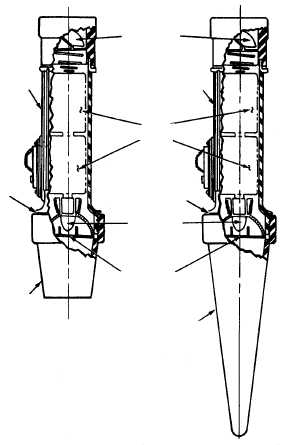During night operations, the plane director uses
two lighted taxi guidance wands (fig. 10-5) in giving
handling signals.
During night flight operations, only the prescribed
signal wands may be used, and then only by authorized
personnel. The wands are different colors and/or shapes
for the personnel designated to use them. The different
colors and/or shapes of the cones on the wands are a
safety factor. The colors/shapes prevent personnel from
misinterpreting a signal that could cause damage to the
aircraft or injury to personnel. Table 10-2 lists the
personnel authorized to use wands by wand color, the
number of wands, and the type. Other personnel that are
involved in night flight operations must use a standard
flashlight with a red filter.
Wands are used at night in the same way that hands
are used for day signaling. Night signals that differ
from day signals are also shown in figure 10-4.
In operations requiring taxiing of aircraft, directors
are usually stationed at intervals of 50 to 100 feet along
the flight deck. The director must be in a position that
will give the pilot an unobstructed view of the signals.
The usual stance of an experienced director ready to
take over control of an aircraft is with one arm high
overhead and palm inward. This not only aids the pilot
in recognizing the director, but it also puts the director
in a position to render practically any taxi signal with a
minimum of movement. The director retains control of
the aircraft only while it is in his control area. He then
passes control to the next director in line on the deck.
For more information on aircraft hand signals refer to
NAVAIR-00-80T-113,
Aircraft
Signals
NATOPS
Manual.
Q10-7. What hand signal is mandatory when
directing fixed-wing aircraft?
Q10-8. When taxiing aircraft, directors are usually
stationed at what intervals of distance along
the flight deck?
SECURING AIRCRAFT ABOARD
CARRIERS
LEARNING OBJECTIVE: Recognize the
importance of securing aircraft and support
equipment, the weather conditions that affect
securing
arrangements,
and
the
aircraft
handling accessories required.
In general, securing aircraft and mobile support
equipment is relative on all naval aviation ships.
CV/(N)
carriers
embark
mostly
fixed-wing
jet,
turboprop, and helicopter aircraft. LHD, LHA, LPH,
and LPD class amphibious assault ships embark
vertical short takeoff and landing (V/STOL) aircraft,
such as the V-22 Osprey, AV-8 Harrier, and a variety of
helicopters. This section does not differentiate between
the different types of ships.
The importance of properly securing and handling
aircraft and mobile support equipment (SE) aboard
carriers cannot be overstressed. It is of the utmost
importance that they are secured in a manner that
prevents fore and aft and athwartship (side to side)
movement. The reasons for this are threefold:
1.
The pitch and roll of the ship, caused by heavy
seas.
2.
The list of the ship, caused by maneuvering,
particularly when making high-speed turns.
3.
Aircraft are parked on the flight and hangar
decks with a minimum of clearance between them.
Adjustable chock assemblies are used to block the
main landing gear of all aircraft and wheels on support
equipment. The chocks should be in position at all
times when the aircraft is not being moved and support
10-26
TAPE
TAPE
TAPE
DIFFUSER
DIFFUSER
BULB
TYPE “C” DRY CELLS
FILTER ASSEMBLY
(COLOR AS
REQUIRED)
WAND CASE
ASSEMBLY
WAND CASE
ASSEMBLY
STUBBY
STANDARD
ANf1005
Figure 10-5.—Taxi guidance wand.


